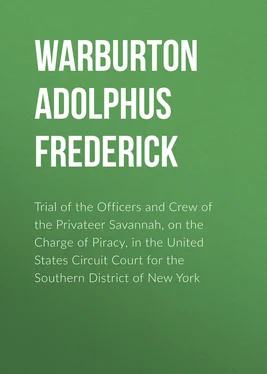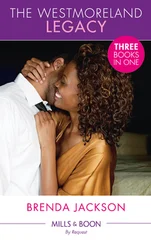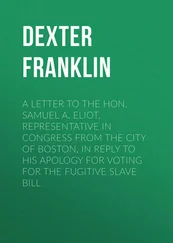Q. Where were they then?
A. I saw them in the lockers that lay in the cabin.
Q. When the Perry's boat came to you where were they?
A. Some out on the table, and some in the lockers.
Q. When you captured the Joseph where were they?
A. I think there were some out on the table, and about the cabin; the pistols, too; but there were none used.
Q. Were any of the men armed?
A. No, sir; I saw none of our men armed, except in their belt they might have a sheath knife.
Q. Where were all hands when you captured the Joseph, in the forenoon of Monday?
A. All on deck, sir; there might be one or two in the forecastle, but most on deck, some lying down, and some asleep.
Q. What size is the Savannah?
A. I think in the neighborhood of 50 to 60 tons.
Q. What is the usual crew for sailing such a vessel, for mercantile purposes?
A. I have been out in such a boat with four men and a boy, besides myself; that was all-sufficient.
Q. Where did you run to?
A. I ran to Havana, and to Key West, with the mails, and returned again in a pilot boat of that size, with four men and a boy, some years ago.
Q. Was the Savannah in use as a pilot boat before that expedition?
A. Yes; that is what she was used for.
Q. Do you know where the Savannah was owned?
A. I believe she was owned in Charleston.
Q. How long have you known her?
A. Two or three years, as a pilot boat.
Q. Do you know her owners?
A. I know one of them.
Q. What was his name?
A. Mr. Lawson.
Q. Is he a citizen of the United States?
A. Yes, I believe so.
Cross-examined by Mr. Larocque.
Q. In speaking of your meeting with the Joseph, you spoke of a conversation that took place between Captain Baker and Captain Meyer, after Captain Meyer came on board the Savannah. Do you not recollect that before that, when Captain Meyer was still on the deck of the Joseph, Captain Baker having called him to come on board the Savannah, and bring his papers, he asked Captain Baker by what authority he called on him to do that?
A. I think this conversation occurred on board the Savannah.
Q. The way you stated was this: that Captain Baker, on board the Savannah, stated to Captain Meyer that he must consider himself and crew prisoners, and his vessel a prize to the Confederate States?
A. Yes, sir.
Q. That was on board the Savannah?
A. It was.
Q. But do you not recollect that before that, when Captain Baker called on the Captain of the Joseph to come on board the Savannah, and bring his papers, Captain Meyer asked by what authority Captain Baker called on him to do that?
A. I do not bear that in mind. I cannot vouch for that. I do not exactly recollect those words, I think the proposition was only made when he was on board the Savannah, but probably it might have been made before.
Q. Did Captain Meyer bring his papers with him?
A. I do not know. I did not see them.
Q. You spoke of having met another vessel after that, and before you fell in with the Perry—I mean the Berkshire—you spoke of her as a British vessel?
A. Yes. We did not speak her.
Q. How did you ascertain the fact that she was a British vessel?
A. We could tell a British vessel by the cut of her sails.
Q. Was the Berkshire, so far as you observed, an armed or an unarmed vessel?
A. I think she was an unarmed vessel. I considered she had been at some of the Southern ports, and had been ordered off.
Q. She was a merchant vessel?
A. Yes.
Q. Which you, from your seamanlike knowledge, thought to be a British vessel?
A. Yes; and I think that the words, "Berkshire, of Liverpool," were on her stern.
Q. Did you read the name on the stern?
A. I think I did.
Q. You had fallen in with the Joseph, one unarmed vessel, and had made her a prize, and her crew prisoners?
A. Yes.
Q. You fell in with the Berkshire, another unarmed vessel, and passed under her stern and did not interfere with her. What was the reason of that difference?
A. We had no right to interfere with her.
Q. Why not?
A. She was not an enemy of the Confederate Government. The policy we were going on, as I understood it, was to take Northern vessels.
Q. Then you were not to seize all the vessels you met with?
A. No; we were not to trouble any others but those that were enemies to the Confederate Government. That was the orders from headquarters. The Captain showed no disposition to trouble any other vessels.
Q. When you were taken on board the Perry were you put in irons?
A. Yes.
Q. Where were those irons put on. Was it on board the Savannah, or after you were put on board the Perry?
A. When we got on board the Perry.
Q. How soon after you went on board the Perry were those irons put on?
A. As soon as our baggage was searched. We were put in the between-decks on board the Perry and irons put on us immediately after we were searched.
Q. Were you in irons when you were transferred from the Perry to the Minnesota?
A. No, sir.
Q. When were the irons taken off?
A. On board the Perry, when we were going into the boat to go on board the Minnesota.
Q. When you were on board the Minnesota were your irons put on again?
A. They were, at night.
Q. Was that the practice—taking them off in the day, and putting them on at night?
A. Yes; we were not ironed at all on that day on board the Minnesota.
Q. When you arrived in Hampton Roads,—you have described the place where the Minnesota lay, about half a mile from the Rip Raps?
A. Yes. (A chart was here handed to witness, and he marked on it the position of the Minnesota off Fortress Monroe.)
Q. As I understand it, you have marked the position of the anchorage of the Minnesota a little further up into the land than on a direct line between the Rip Raps and Fortress Monroe? A. Yes, sir.
Q. You were then taken on board the Harriet Lane, from the Minnesota?
A. Yes.
Q. Where did the Harriet Lane lie when you were taken on board of her?
A. She was further up into the Roads, about half a mile from the Minnesota, westward. (Witness marked the position of the Harriet Lane on the chart.)
Q. You are familiar with these Roads?
A. Yes, sir; for years.
Q. You know the town of Hampton?
A. Yes.
Q. And the college there?
A. Yes.
Q. How, with reference to the college at Hampton, did the Harriet Lane lie?
A. The college at Hampton appeared N.N.W., and at a distance of a mile and a quarter, or a mile and a half.
Q. How were you taken from the Minnesota on board the Harriet Lane?
A. The ship's crew took us in a boat.
Q. In one trip, or more trips?
A. We all went in one of the ship's boats.
Q. On what day was that?
A. I do not bear in mind exactly.
Q. Was the Harriet Lane ready to sail when you were taken on board of her?
Читать дальше












